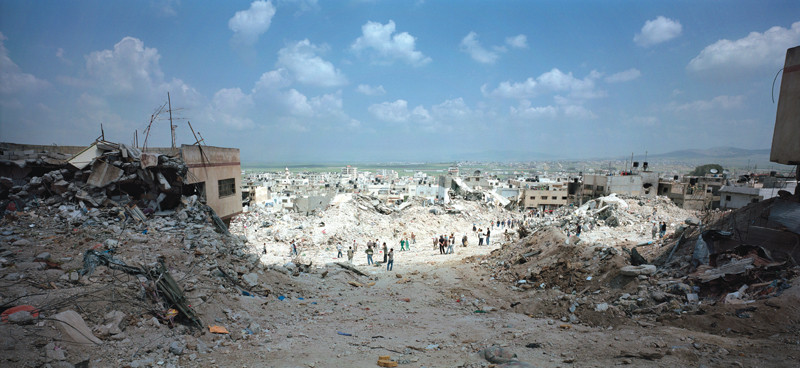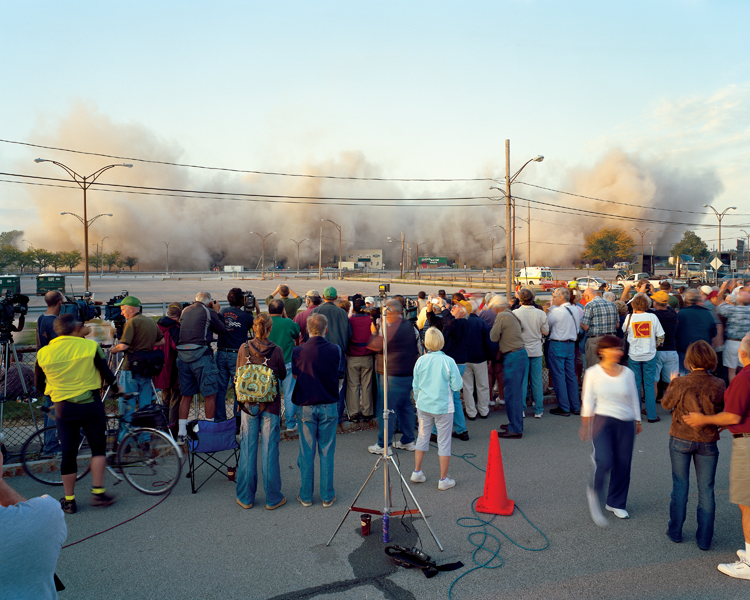[Fall 2008]
Contact Photography Festival
Museum of Contemporary Canadian Art, Toronto
May 1 – 31, 2008
On a bright Saturday morning back in early May, I came upon a strange sight on Queen Street West. In front of the Museum of Contemporary Canadian Art (MoCCA), and spilling onto the sidewalk, a considerable crowd had gathered to look at an extremely large work by Robert Burley. Implosion of Buildings #65 & #69 (2007) was stencilled onto a blank wall facing the MoCCA courtyard. What made this scene most peculiar was the fact that the work itself showed a crowd of onlookers observing the implosion of a building. A crowd looking at a crowd looking at a cloud.
As the introductory work to an exhibition about memory and history, this work by Burley did a remarkable job of introducing the idea of layers – a concept that was richly developed inside the museum. By definition, memories are of the intimate realm, while history resides in the public sphere. As laid out by the curators of the exhibition, David Liss and Bonnie Rubenstein, this exhibition was set out to “probe relationships that exist… moments of personal significance to events of global resonance that affect each one of us.” Though this may seem an incredibly vague and daunting task to some, Liss and Rubenstein mounted an exhibition that was both rich and insightful in its approach to the question. Each of the selected artists contributed a very different perspective on the topic, yet when one read them for their portrayal of the various layers and mnemonic tools that structure the link between individuals and memories or history, there emerged a strong narrative.
Exhibited in a darkened room of the museum, Nan Goldin’s Heartbeat (2001) is a multimedia installation that includes 246 colour slides depicting couples in the midst of lovemaking and intimate familial moments. These highly personal images are accompanied by John Taverner’s soundtrack of part of the Christian mass performed by pop singer Björk. Due to its mise-en-scène and the emotionally raw quality of Goldin’s images, this work feels like an unhindered access to private memories. At times, it even has a strong voyeuristic quality. I cannot think of a better portrayal of memories; those moments that you imagine could become cherished snapshots in a private photo album.
In Gravitas, Autoportrait au couteau (2007), a work by Raymonde April, we see the artist gently scraping away layers of paint that had accumulated on the walls of her Montreal apartment since the 1920s. Nowhere in the exhibition is the link between layers and the history/memory question expressed so literally. In its heyday, each layer of paint witnessed countless moments that are now memories. Who knows; perhaps some of these moments even contributed to or influenced Montreal’s history.
Another artist presented in the exhibition had an entirely different relationship with historical moments. Luc Delahaye is an award-winning photojournalist who is known for his large-scale colour works depicting conflicts, world events, and social issues. The self-explanatory Jenin Refugee Camp (2002) puts viewers in direct contact with the Israeli-Palestinian conflict and, as such, should constitute a direct access to history in the making. Yet the photograph itself constitutes a subjective layer. The grand panorama format and the dramatic lighting transform the scene into a disturbingly attractive stage set. Invariably, viewers will return home with a personal memory of Delahaye’s subjective portrayal of a historical event.
The large format of Delahaye’s work is echoed a few feet away in a work by German artist Thomas Ruth. However, Ruth’s jpeg bd01 (2007) illustrates a more common – and incredibly more remote – access to history. He uses found images from the Internet and blows them to gigantesque sizes. The traces of this transformation are clearly visible in the over-sized pixels that give the work a pointillist feel. In these pixels, we can read the incommensurable distance between our private daily routines (online and offline) and the almost unidentifiable sites of history. Historically, large frescoes were often produced as elaborate mnemonic tools for the dissemination (and structuring) of history. The same now occurs through the World Wide Web, but in a cacophony of voices and at the cost of visually overloading our lives.
The links between sites of memories and sites of history is, at best, elusive, since history and its dissemination continuously go through a number of filtering layers that transform them for their inclusion in our collective memory. Yet, most individuals show an unquenchable thirst for sites of history. In his series Small World (1996, 2007), Martin Parr has photographed tourists as they visit and photograph (or film) touristic historical sites. The result is often humoristic: in his Turkey, Kalkan (1994), a sun-hat-clad tourist films the “exotic” Turkish countryside from atop an “authentic” donkey as a Turkish man walks the donkey along a narrow footpath. Parr shows us a succession of layers/filters through which Turkish history and sites will later be disseminated to the world. In this series, he highlights our position as visitors looking at tourists looking at a site. Layers upon layers.
Jean-François Bélisle is the editorial assistant for Ciel variable magazine and also acts as an independent curator and critic. He holds a master’s degree in art history from Concordia University.



